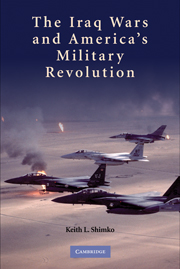Book contents
- Frontmatter
- Contents
- Acknowledgments
- 1 Military Revolutions and the Iraq Wars
- 2 From Vietnam to Iraq – The Rebirth of American Military Power and the Origins of an RMA
- 3 The First Iraq War, 1991 – A Revolution Dawns?
- 4 The Iraqi Interregnum, 1991–2000
- 5 Afghanistan and the Second Iraq War, 2001–2003 – A Revolution Confirmed?
- 6 The Third Iraq War, 2003–? – A Revolution Denied?
- Conclusion: The Future of America's Military Revolution
- Index
- References
4 - The Iraqi Interregnum, 1991–2000
Published online by Cambridge University Press: 05 June 2012
- Frontmatter
- Contents
- Acknowledgments
- 1 Military Revolutions and the Iraq Wars
- 2 From Vietnam to Iraq – The Rebirth of American Military Power and the Origins of an RMA
- 3 The First Iraq War, 1991 – A Revolution Dawns?
- 4 The Iraqi Interregnum, 1991–2000
- 5 Afghanistan and the Second Iraq War, 2001–2003 – A Revolution Confirmed?
- 6 The Third Iraq War, 2003–? – A Revolution Denied?
- Conclusion: The Future of America's Military Revolution
- Index
- References
Summary
The Calm After the Storm
It is hard to argue with success, and there is little doubt that Desert Storm was a success, at least in military terms. Certainly the war revealed deficiencies, and nothing is ever perfect. But on the whole, the war's result was taken as a vindication of American defense policy over the preceding fifteen years. Not everyone had been convinced that the United States was on the right track. Politicians and defense analysts associated with the “military reform movement” in the early 1980s, for example, viewed with suspicion the Defense Department's fascination or fixation with high-tech weapons they considered too expensive, complex, and unreliable. Better they thought to acquire a larger quantity of cheaper weapons that worked than some technological marvel prone to breakdown that might be too expensive to risk losing in battle. The Gulf War appeared to resolve this debate as key weapons systems performed better than even many of their supporters hoped. This positive evaluation of the road taken was easily transformed into a prospective judgment about the road ahead: American defense policy should continue along the same trajectory that brought it from Vietnam to Desert Storm. Not only is it difficult to argue with success; it is also best not to mess with it.
Reflecting an assessment similar to that of the Gulf War Air Power Survey, Michael Vickers argues that “when the Cold War ended and victory in the Persian Gulf endowed the United States with the mantel of the ‘world's only superpower,’ Americans found themselves in the possession of a force already exhibiting incipient RMA capabilities – stealth, precision-guided munitions (PGMs) and all weather-imaging satellites, for example.
- Type
- Chapter
- Information
- The Iraq Wars and America's Military Revolution , pp. 91 - 130Publisher: Cambridge University PressPrint publication year: 2010



